Yaojun Wu
QVRF: A Quantization-error-aware Variable Rate Framework for Learned Image Compression
Mar 10, 2023Abstract:Learned image compression has exhibited promising compression performance, but variable bitrates over a wide range remain a challenge. State-of-the-art variable rate methods compromise the loss of model performance and require numerous additional parameters. In this paper, we present a Quantization-error-aware Variable Rate Framework (QVRF) that utilizes a univariate quantization regulator a to achieve wide-range variable rates within a single model. Specifically, QVRF defines a quantization regulator vector coupled with predefined Lagrange multipliers to control quantization error of all latent representation for discrete variable rates. Additionally, the reparameterization method makes QVRF compatible with a round quantizer. Exhaustive experiments demonstrate that existing fixed-rate VAE-based methods equipped with QVRF can achieve wide-range continuous variable rates within a single model without significant performance degradation. Furthermore, QVRF outperforms contemporary variable-rate methods in rate-distortion performance with minimal additional parameters.
A Dataset and Method for Hallux Valgus Angle Estimation Based on Deep Learing
Jul 08, 2021



Abstract:Angular measurements is essential to make a resonable treatment for Hallux valgus (HV), a common forefoot deformity. However, it still depends on manual labeling and measurement, which is time-consuming and sometimes unreliable. Automating this process is a thing of concern. However, it lack of dataset and the keypoints based method which made a great success in pose estimation is not suitable for this field.To solve the problems, we made a dataset and developed an algorithm based on deep learning and linear regression. It shows great fitting ability to the ground truth.
Learned Block-based Hybrid Image Compression
Jan 18, 2021



Abstract:Recent works on learned image compression perform encoding and decoding processes in a full-resolution manner, resulting in two problems when deployed for practical applications. First, parallel acceleration of the autoregressive entropy model cannot be achieved due to serial decoding. Second, full-resolution inference often causes the out-of-memory(OOM) problem with limited GPU resources, especially for high-resolution images. Block partition is a good design choice to handle the above issues, but it brings about new challenges in reducing the redundancy between blocks and eliminating block effects. To tackle the above challenges, this paper provides a learned block-based hybrid image compression (LBHIC) framework. Specifically, we introduce explicit intra prediction into a learned image compression framework to utilize the relation among adjacent blocks. Superior to context modeling by linear weighting of neighbor pixels in traditional codecs, we propose a contextual prediction module (CPM) to better capture long-range correlations by utilizing the strip pooling to extract the most relevant information in neighboring latent space, thus achieving effective information prediction. Moreover, to alleviate blocking artifacts, we further propose a boundary-aware postprocessing module (BPM) with the edge importance taken into account. Extensive experiments demonstrate that the proposed LBHIC codec outperforms the VVC, with a bit-rate conservation of 4.1%, and reduces the decoding time by approximately 86.7% compared with that of state-of-the-art learned image compression methods.
FAN: Frequency Aggregation Network for Real Image Super-resolution
Sep 30, 2020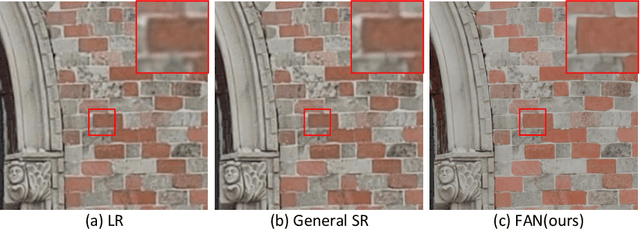

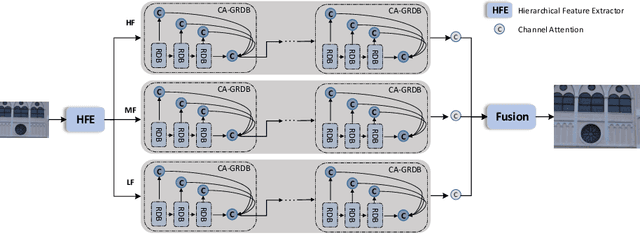

Abstract:Single image super-resolution (SISR) aims to recover the high-resolution (HR) image from its low-resolution (LR) input image. With the development of deep learning, SISR has achieved great progress. However, It is still a challenge to restore the real-world LR image with complicated authentic degradations. Therefore, we propose FAN, a frequency aggregation network, to address the real-world image super-resolu-tion problem. Specifically, we extract different frequencies of the LR image and pass them to a channel attention-grouped residual dense network (CA-GRDB) individually to output corresponding feature maps. And then aggregating these residual dense feature maps adaptively to recover the HR image with enhanced details and textures. We conduct extensive experiments quantitatively and qualitatively to verify that our FAN performs well on the real image super-resolution task of AIM 2020 challenge. According to the released final results, our team SR-IM achieves the fourth place on the X4 track with PSNR of 31.1735 and SSIM of 0.8728.
AIM 2020 Challenge on Real Image Super-Resolution: Methods and Results
Sep 25, 2020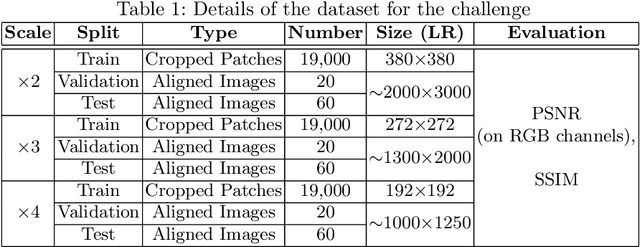
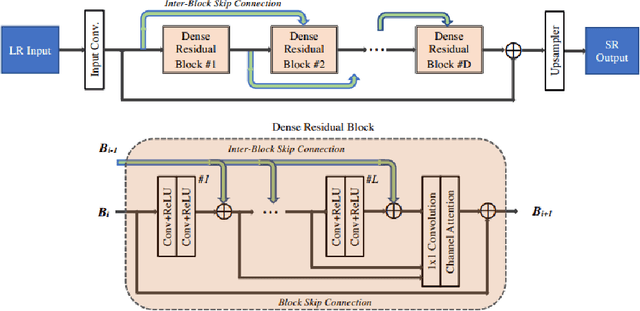
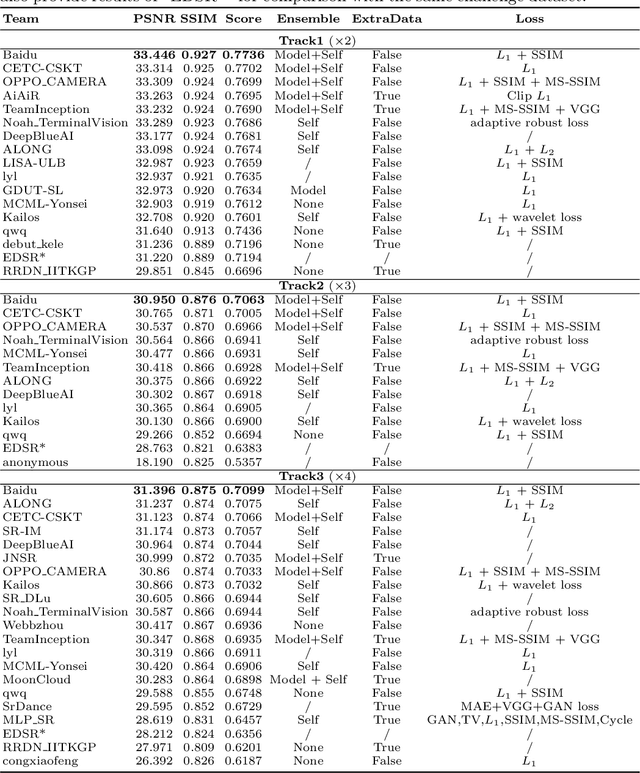
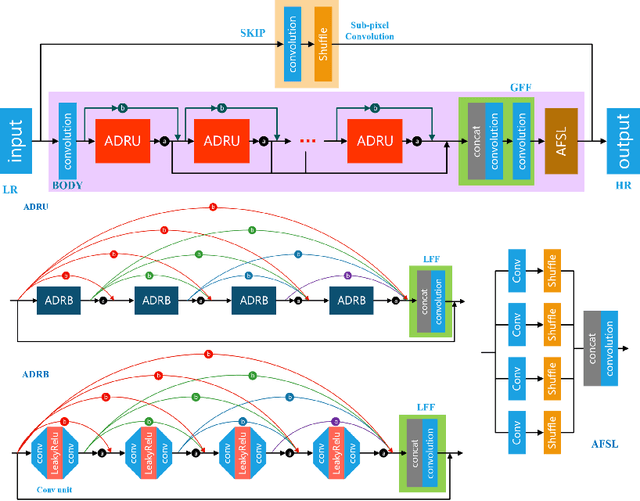
Abstract:This paper introduces the real image Super-Resolution (SR) challenge that was part of the Advances in Image Manipulation (AIM) workshop, held in conjunction with ECCV 2020. This challenge involves three tracks to super-resolve an input image for $\times$2, $\times$3 and $\times$4 scaling factors, respectively. The goal is to attract more attention to realistic image degradation for the SR task, which is much more complicated and challenging, and contributes to real-world image super-resolution applications. 452 participants were registered for three tracks in total, and 24 teams submitted their results. They gauge the state-of-the-art approaches for real image SR in terms of PSNR and SSIM.
Learning Disentangled Feature Representation for Hybrid-distorted Image Restoration
Jul 22, 2020



Abstract:Hybrid-distorted image restoration (HD-IR) is dedicated to restore real distorted image that is degraded by multiple distortions. Existing HD-IR approaches usually ignore the inherent interference among hybrid distortions which compromises the restoration performance. To decompose such interference, we introduce the concept of Disentangled Feature Learning to achieve the feature-level divide-and-conquer of hybrid distortions. Specifically, we propose the feature disentanglement module (FDM) to distribute feature representations of different distortions into different channels by revising gain-control-based normalization. We also propose a feature aggregation module (FAM) with channel-wise attention to adaptively filter out the distortion representations and aggregate useful content information from different channels for the construction of raw image. The effectiveness of the proposed scheme is verified by visualizing the correlation matrix of features and channel responses of different distortions. Extensive experimental results also prove superior performance of our approach compared with the latest HD-IR schemes.
Memorize, Then Recall: A Generative Framework for Low Bit-rate Surveillance Video Compression
Dec 30, 2019



Abstract:Surveillance video applications grow dramatically in public safety and daily life, which often detect and recognize moving objects inside video signals. Existing surveillance video compression schemes are still based on traditional hybrid coding frameworks handling temporal redundancy by block-wise motion compensation mechanism, lacking the extraction and utilization of inherent structure information. In this paper, we alleviate this issue by decomposing surveillance video signals into the structure of a global spatio-temporal feature (memory) and skeleton for each frame (clue). The memory is abstracted by a recurrent neural network across Group of Pictures (GoP) inside one video sequence, representing appearance for elements that appeared inside GoP. While the skeleton is obtained by the specific pose estimator, it served as a clue for recalling memory. In addition, we introduce an attention mechanism to learn the relationships between appearance and skeletons. And we reconstruct each frame with an adversarial training process. Experimental results demonstrate that our approach can effectively generate realistic frames from appearance and skeleton accordingly. Compared with the latest video compression standard H.265, it shows much higher compression performance on surveillance video.
 Add to Chrome
Add to Chrome Add to Firefox
Add to Firefox Add to Edge
Add to Edge